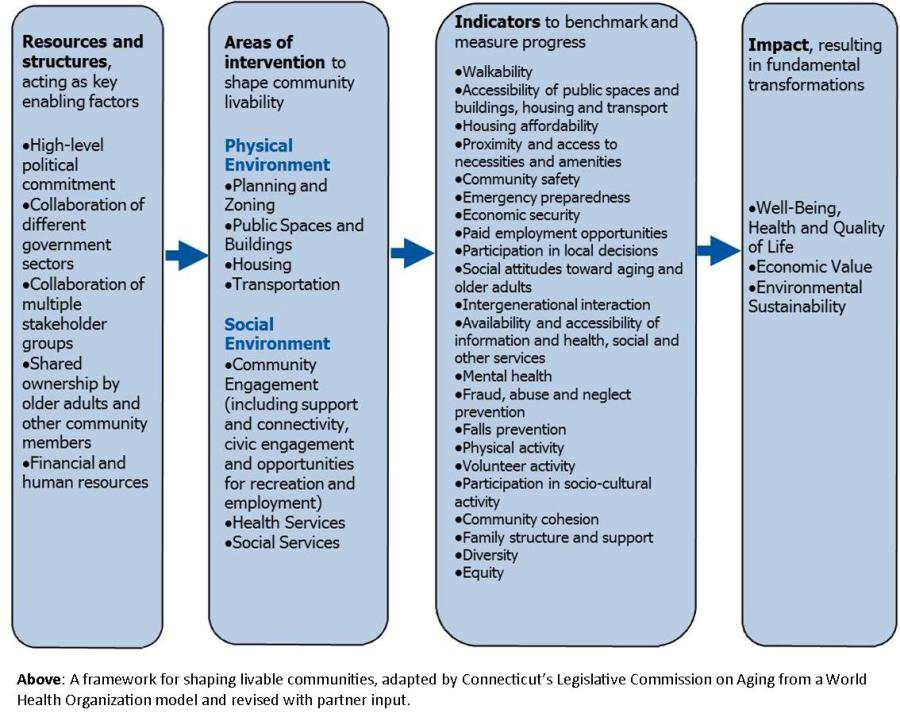Background
Connecticut for Livable Communities is an initiative of Connecticut’s Commission on Women, Children and Seniors to prepare Connecticut for its growing aging population while promoting policies that enhance the lives of the present and future generations of older adults.
Through our collaborative and long-standing work in changing how and where people receive long-term services and supports, we know that people want to stay in their homes and communities and to have choice, independence and dignity. And recognizing unprecedented longevity in Connecticut’s population, coupled with sheer increases in the number of older adults, the Connecticut General Assembly charged Connecticut’s Legislative Commission on Aging with facilitating this initiative (Public Act 13-109).
Did You Know?
- Connecticut has the 3rd highest life expectancy in the nation, at 80.8 years.
- Connecticut is the 7th oldest state in the nation, based on median age.
- Between 2010 and 2040, Connecticut’s population of people age 65 and older is projected to grow by 57%. Its population of people age 20 to 64 is projected to grow by less than 2% during the same period.
- These demographic shifts represent a permanent transformation not only for Connecticut but around the globe.
Definitions
Livable communities are places that foster independence and support residents across the lifespan. They offer affordable, accessible, and diverse housing and transportation options and public buildings and spaces; supportive community features and services; and vibrancy and opportunities for community engagement. They engage residents in civic and social life, and allow people to remain in their homes and communities. Done well, they enhance the quality of life for all residents, create tremendous economic value in towns and cities, promote healthy living and support environmental sustainability.
Resources
Benefits of Livable Communities

Older adults generally want to remain in their familiar home and neighborhood environments. Creating livable communities successfully allows people to age in place. And the same principles that make a community “livable” for older adults benefit everyone.
Livable communities are attractive to all ages. Livable communities features are also likely to attract residents from across the lifespan, including professionals needed to support aging in place and in community. These features include broad housing and transportation options in higher-density, vibrant areas with public amenities and lively commercial districts.
Livable communities create economic value. Livable communities have been associated with increases in home values, higher property and sales tax revenues, savings on service delivery and infrastructure costs, growth in business revenues and development opportunities, and decreased individual transportation costs.
Livable communities promote health. Community conditions can impact physical activity levels, food access, air quality, and social cohesion. Livable communities increase opportunities for every resident to make healthy choices.
Livable communities drive environmentally responsible development. Increasing density and broadening the array of viable transportation options reduces natural resource consumption and pollution, and creating smaller energy-efficient housing is an important part of climate change strategy.
Vision, Mission and Values
Vision
Shaping great places for people to grow up and grow older
Mission
To convene, engage, inspire, and support local, regional and state efforts to shape more livable communities in Connecticut for residents across the lifespan.
Values
- Accessible. Every aspect of community design and life ought to be accessible to and promote the engagement of its residents, regardless of physical or cognitive ability.
- Choice. Communities should promote personal dignity and functional independence across the lifespan by creating a broad array of choices to meet their evolving needs.
- Cooperative. Creating livable communities requires partnership across a wide variety of sectors, within-town collaboration across departments, and regional cooperation.
- Equity. Everyone deserves the ability to live in one’s home and community safely, independently and comfortably, regardless of age, race, gender, sexual orientation, gender identity or expression, income or ability level.
- Intergenerational. Intergenerational communities can leverage strengths across the lifespan by linking the needs and skills of different age groups.
Framework and Data
The Commission on Women, Children and Seniors embraces the following framework for this initiative.

Resources
Our Partners
Creating livable communities is a multi-faceted and multi-disciplinary endeavor, requiring partnership with, among others, municipal leaders, representatives of local senior and social services offices, community stakeholders, planning and zoning board members and commissioners, philanthropists, and social services and health organizations. To date we have strategically cultivated nearly 60 organizational partners, through which we connect related initiatives to maximize resources and expertise to shape community livability.
AARP – Connecticut
African-American Affairs Commission
Aging Affinity Group
Alzheimer’s Resource Center of Connecticut
Bike-Walk Connecticut
Capitol Region Council of Governments
Center for Disability Rights
Center for Transportation and Livable Systems of the Connecticut Transportation Institute
Community Foundation for Greater New Haven
Community Solutions
Connecticut Asian Pacific American Affairs Commission
Connecticut Association of Area Agencies on Aging
Connecticut Association of Directors of Health
Connecticut Association of Senior Center Personnel
Connecticut Association for Community Transportation
Connecticut Chapter of the American Planning Association
Connecticut Collaboration for Fall Prevention
Connecticut Community Care, Inc.
Connecticut Community Foundation
Connecticut Conference of Municipalities
Connecticut Council for Philanthropy
Connecticut Council on Problem Gambling
Connecticut Council of Small Towns
Connecticut Data Collaborative
Connecticut Economic Development Association
Connecticut Fair Housing Center
Connecticut Fund for the Environment
Connecticut Health Foundation
Connecticut Housing Finance Authority
Connecticut Local Administrators of Social Services
Connecticut Main Street Center
Connecticut Public Health Association
Connecticut State Data Center
Data Haven
Department of Developmental Services
Department of Housing
Department of Mental Health and Addicition Services
Department of Public Health
Department of Social Services
Department of Transportation
Fairfield County Community Foundation
Foundation for Community Health
Greater Hartford Transit District
Home Haven
Jewish Community Foundation of Greater Hartford
LeadingAge Connecticut
LGBT Aging Advocacy
Lower Connecticut River Valley Council of Governments
Manchester Housing Authority
Northeastern Connecticut Council of Governments
Northwest Hills Council of Governments
Open Communities Alliance
Partnership for Strong Communities
Permanent Commission on the Status of Womem
The Peter and Carmen Lucia Buck Foundation, Inc.
Regional Plan Association
South Central Regional Council of Governments
Technology Transfer Center of the Connecticut Transportation Institute
Tri-State Transportation Campaign
State Department on Aging
United Way of Connecticut
University of Connecticut’s Center for Land Used Education and Research
Western Council of Governments
Young Energetic Solutions
Legislation

Public Policies and Livable Communities
State-level legislation and public policies can support and inspire the critical local and regional initiatives and opportunities needed to realize livable communities that support aging in place. The Commission on Women, Children and Seniors works with members of the Connecticut General Assembly and various partners to identify and promote innovative and wide-ranging legislation related to livable communities and aging in place. Areas range from telehealth to economic security to countless initiatives in between.
Legislative Highlights
2015:
Public Act 15-41 improves bicyclist safety and transportation options in Connecticut. Public Act 15-57 expands tax increment financing (a special funding tool that promotes investments in downtowns), allowing municipalities to create a defined district and plan, and then use the tax revenues generated within the district for investment within the area. Public Act 15-1 (Section 229) allows a nonprofit organization contracted by the Department of Rehabilitative Services to administer the grant program authorized by Public Act 14-98 (see description below under “2014”).
2014:
Public Act 14-98 authorized $6 million in bonding money to provide grants to older adults and persons with disabilities to make home modifications and purchase assistive technology so they can remain in their homes.
Public Act 14-73 requires Connecticut’s Legislative Commission on Aging to recognize communities that have implemented livable community initiatives.
2013:
Public Act 13-109 created a livable communities initiative to help municipalities prepare for the growing aging population. It required Connecticut’s Legislative Commission on Aging to
- Serve as a forum for best practices and a resource clearinghouse;
- Establish and facilitate partnerships;
- Identify various public and private funding sources;
- Create a livable communities website; and
- Report annually on the initiative to the Connecticut General Assembly’s Committees on Aging, Housing, Human Services and Transportation.
Public Act 13-250 implemented many recommendations of the Aging In Place Task Force (Special Act 12-6), making changes in several statutes to help people remain in their own homes and communities as they age. Specifically, it:
- Requires a coordinated outreach system to increase the use of the supplemental nutrition assistance program;
- Suggests that local plans of conservation and development include a component of planning for older adults and individuals with disabilities to remain in their homes and communities;
- Specifies that a ramp for wheelchair use be included in the list of visitable features that are exempted from obtaining a State Building Code variance;
- Expands the list of mandated elder abuse reporters and establishes a new training requirement for their employers;
- Requires the Department of Social Services to issue a yearly report to the Connecticut General Assembly, detailing the number of elder abuse complaints and disposition of complaints from the previous calendar year; and
- Requires a public awareness campaign to educate older adults on ways to resist aggressive marketing tactics.
Reports
Public Act 13-109 requires the Commission to report annually on Connecticut for Livable Communities to the Connecticut General Assembly’s Committees on Aging, Housing, Human Services and Transportation. We are pleased to share our annual progress.
Livable Communities: Generating Revenue, Saving Money – Livable Communities are places that foster independence and support residents across the lifespan. They are attractive to all ages. And they’re a smart investment for Connecticut. This fact sheet, prepared for our 2015 Partners Summit provides livability examples of quantifiable value.
Transportation Policy Brief: How Can We Best Support Residents’ Transportation Needs Across the Lifespan in Connecticut? – This report analyzes responses from our statewide survey and provides policy recommendations on transportation, in light of the state’s rapidly changing demographics. Transportation is the vital link that connects residents across the lifespan with their communities and the elements of a vibrant and engaged life.
Housing Report: Connecticut Adults Want Affordable Housing in Walkable Neighborhoods of Opportunity – This second report in our series analyzes responses from our statewide survey and provides policy recommendations on housing, including the need for an array of housing choices–both in type and affordability–in every Connecticut community.

